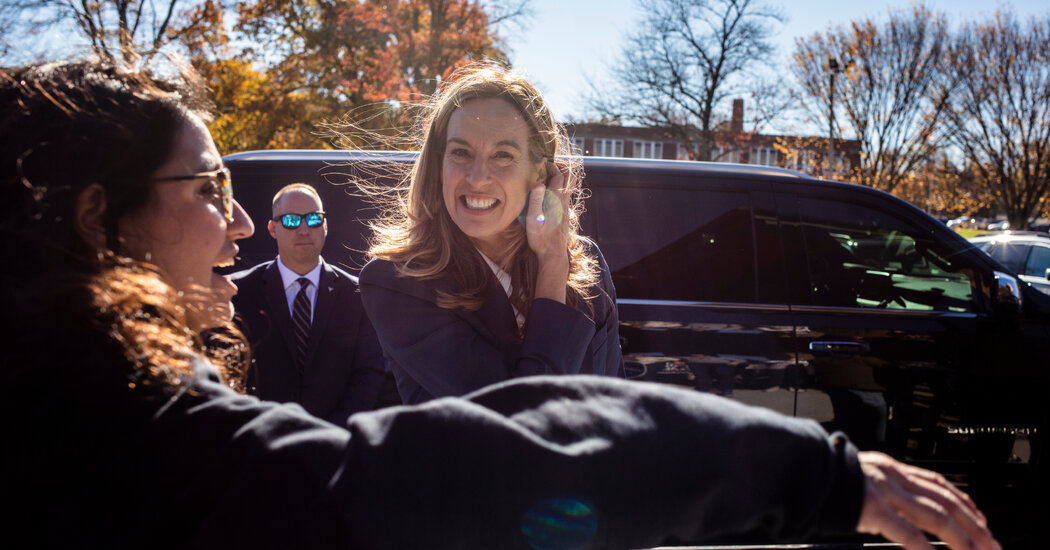The race was expected to be close. In fact, it was a blowout.
Representative Mikie Sherrill beat Jack Ciattarelli by a wide margin, becoming the second woman to be elected governor of New Jersey.
Ms. Sherrill, a Democrat, made her opposition to President Trump the cornerstone of her campaign against Mr. Ciattarelli, a Republican who crisscrossed the state with fervor, trying to replicate the inroads Mr. Trump made with Latino and Black voters in New Jersey last November.
Mr. Ciattarelli, who was endorsed by Mr. Trump in May, had gambled that his new alliance with a president he once called a charlatan would help him run up the score, even in a left-leaning state.
The risky strategy fell apart for several reasons.
Sherrill energized the Democratic base.
Mr. Ciattarelli’s near victory in his previous run for governor in 2021 and Mr. Trump’s better-than-expected showing in 2024 had Democrats in New Jersey worrying that the reliably blue state might be drifting away from them.
But Ms. Sherrill was able to energize the Democratic coalition in New Jersey that had dominated the state for a decade, putting her on pace to match even Gov. Philip D. Murphy’s decisive 2017 victory. She ran up large margins in suburban counties like Bergen, Middlesex and Union.
Hudson County, the densely populated urban county across the Hudson River from New York City, with a significant Latino population, improved 20 percentage points for Democrats over the 2024 margins. Essex County, home to Newark and many densely populated suburbs, improved eight points over the 2024 margins.
Trump gave Sherrill an unexpected gift.
After the federal government shut down, Mr. Trump made what many Democrats saw as an unforced error. In October.
While tangling with Senator Chuck Schumer of New York, the president announced that he had “terminated” construction of a vitally important new Hudson River rail tunnel between New York and New Jersey.
New Jersey commuters, who still recall a similar cancellation of funding for the tunnel by the state’s last Republican governor, Chris Christie, took notice. And Ms. Sherrill reminded voters daily about what was at stake if the $16 billion passage, known as Gateway, hit another dead end.
It also gave Ms. Sherrill a way to change the subject from two campaign controversies: why she did not participate in her graduation from the U.S. Naval Academy and why she had accused Mr. Ciattarelli of “killing tens of thousands” of New Jersey residents during the opioid epidemic.
Turnout soared.
According to estimates, New Jersey was on pace for the highest turnout rate in an election for governor there since 1997, when 56 percent of registered voters cast a ballot.
This year, turnout appeared to be close to 50 percent. And in raw vote totals, the state crossed the three-million-voter threshold for the first time in history.
The surge seemed to come mostly from Democrats, who improved their overall vote totals in nearly every county in the state. In urban Hudson County, 30,000 more Democrats turned out this year than four years ago. In rural Gloucester County, it was 20,000 more Democrats. And in suburban Middlesex County, it was 46,000 more Democrats.
Sherrill’s anti-Trump message resonated powerfully.
Mr. Ciattarelli tried to walk a fine line, embracing some of Mr. Trump’s policies while avoiding mention of his name.
It was a balancing act that was made even harder by Mr. Trump’s frequent laudatory posts on social media. In the final weeks of the campaign the president also hosted two telephone pep rallies for Mr. Ciattarelli. In the first, Mr. Ciattarelli lavished the president with praise.
“How privileged we are to have him with us tonight,” Mr. Ciattarelli told callers. “We’re very thankful for all that he’s done to secure the border and enhance national security. We’re very thankful for all he’s done to improve the economy. And I’m sure people notice what’s going on with gas prices!”
But while Mr. Ciattarelli struck a balancing act, Ms. Sherrill went all in on her attacks on the president, recognizing that all politics are nationalized in the Trump era.
She labeled Mr. Ciattarelli the “Trump of Trenton.” She also ran ads highlighting the grade that Mr. Ciattarelli gave the president’s tumultuous second term. (“Right now, I’d certainly give the president an A,” Mr. Ciattarelli said in the second general election debate. “I think he’s right about everything that he’s doing.”)
Ms. Sherrill’s strategy made sense, mathematically.
There are 850,000 more registered Democrats than Republicans in New Jersey.
And while many national Democrats fretted that Mr. Trump had come within six points of Vice President Kamala Harris in New Jersey last November, state party leaders instead focused on the bottom line: He still lost to Ms. Harris in New Jersey by more than 250,000 votes.
Republicans saw a drop-off without Trump on the ballot.
Counties across New Jersey drifted back toward Democrats when compared with the 2024 election, seemingly erasing most of the gains Mr. Trump made in 2024.
The nearly universal county-by-county swing back to Democrats followed a trend that has plagued Republicans in any nonpresidential year: A significant segment of the party’s voters turn out only when Trump’s name is on top of the ballot.
But in an election in which turnout surged compared with the governor’s race four years ago, Mr. Ciattarelli also failed to improve on his overall vote totals.
In deeply Republican and rural counties like Sussex and Warren, Mr. Ciattarelli won roughly the same number of voters this year as in 2021.
And in Democratic-leaning counties like Union and Middlesex, Mr. Ciattarelli improved by just a few thousand votes over his 2021 totals, while Ms. Sherrill improved by the tens of thousands.
In a battle over biography, Sherrill won.
Mr. Ciattarelli ran as a Jersey guy. Ms. Sherrill ran as a Navy pilot.
Navy won.
Campaigns often lean heavily into biographies and résumés, and both candidates made their backgrounds a core element of their pitches to voters.
Ms. Sherrill’s mentions of her Navy service became so prevalent that even she began joking about it in stump speeches. She filmed ads in a helicopter. An image of a helicopter was even embedded in her campaign website’s logo.
Mr. Ciattarelli also returned frequently to the story of his family’s deep roots in the state, as a third-generation Italian American. His three most–aired ads in the final month of the campaign all began with his biography: “New Jersey’s been home to my family for more than 100 years.”
He obsessed over diners, visiting more than 130, according to his campaign, and made his favorite order — a BLT on toasted rye — a comedic aside in his stump speech.
But his campaign also admitted what could be an unpopular opinion: Mr. Ciattarelli prefers Frank Sinatra over Bruce Springsteen.
And in the end, New Jersey, a proudly parochial state, chose a Navy pilot from Virginia.
Nick Corasaniti is a Times reporter covering national politics, with a focus on voting and elections.
Tracey Tully is a reporter for The Times who covers New Jersey, where she has lived for more than 20 years.
The post 6 Takeaways From Democrat Mikie Sherrill’s Victory in New Jersey appeared first on New York Times.




